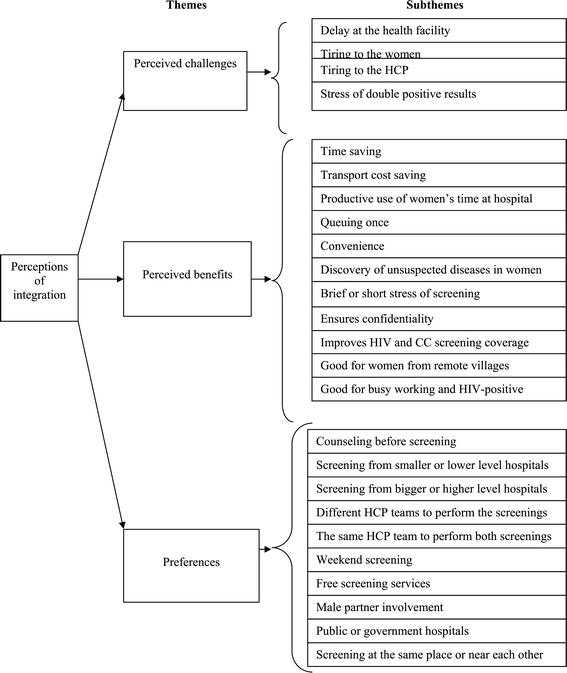Integration of HIV and cervical cancer screening perceptions and preferences of communities in Uganda
- PMID: 25783655
- PMCID: PMC4359479
- DOI: 10.1186/s12905-015-0183-4
Integration of HIV and cervical cancer screening perceptions and preferences of communities in Uganda
Abstract
Background: Despite the fact that HIV-positive women carry an increased risk of developing cervical cancer (CC) in comparison with HIV-negative women, HIV and CC screening programs in many developing countries have remained unintegrated. The objective of this study is to explore perceptions and preferences of community members in Uganda, including women, men, and village health teams, regarding the integration of HIV and CC screening services in a single-visit approach.
Methods: This qualitative study was conducted in three districts in Uganda. Data were collected through focus group discussions with women and village health teams, and individual interviews with men. Respondents were purposely selected from among those linked to three CC clinics in the three districts. The content analysis method was used to analyze the data.
Results: Three themes emerged from the data, namely appreciating the benefits of integration, worrying about the challenges of integration, and preferences for integration. The women endorsed the benefits. However, there were worries that integration would prolong the waiting time at the health facility and induce tiredness in both the healthcare providers and the women. There were also fears of being found positive for both HIV and CC and the consequences such as stress, self-isolation, and social conflicts. Participants, particularly the women, considered the challenges of screening integration to be manageable by, for example, taking a day off work to visit the hospital, delegating house chores to other family members, or taking a packed lunch on visiting the hospital.
Conclusions: The community members in Uganda perceive the benefits of HIV and CC screening integration to outweigh the challenges, and expect that the challenges can be minimized or managed by the women. Therefore, when considering HIV and CC screening integration, it is important to not only recognize the benefits but also take into consideration the perceived challenges and preferences of community members.
Similar articles
-
Knowledge, facilitators and barriers to cervical cancer screening among women in Uganda: a qualitative study.BMJ Open. 2017 Jun 11;7(6):e016282. doi: 10.1136/bmjopen-2017-016282. BMJ Open. 2017. PMID: 28606908 Free PMC article.
-
Integration of HIV and cervical cancer screening perceptions of healthcare providers and policy makers in Uganda.BMC Public Health. 2014 Aug 7;14:810. doi: 10.1186/1471-2458-14-810. BMC Public Health. 2014. PMID: 25099996 Free PMC article.
-
Acceptability of integration of cervical cancer screening into routine HIV care, associated factors and perceptions among HIV-infected women: a mixed methods study at Mbarara Regional Referral Hospital, Uganda.BMC Health Serv Res. 2023 Apr 3;23(1):333. doi: 10.1186/s12913-023-09326-6. BMC Health Serv Res. 2023. PMID: 37013535 Free PMC article.
-
Providers and women's perspectives on opportunities, challenges and recommendations to improve cervical cancer screening in women living with HIV at Mbarara Regional Referral Hospital: a qualitative study.BMC Womens Health. 2024 Jul 8;24(1):392. doi: 10.1186/s12905-024-03239-0. BMC Womens Health. 2024. PMID: 38978020 Free PMC article.
-
Facilitators and Barriers to HIV Screening: A Qualitative Meta-Synthesis.Qual Health Res. 2016 Feb;26(3):294-306. doi: 10.1177/1049732315616624. Epub 2015 Dec 1. Qual Health Res. 2016. PMID: 26631679 Review.
Cited by
-
Mapping the effectiveness of integrating mental health in HIV programs: a scoping review.BMC Health Serv Res. 2023 Apr 24;23(1):396. doi: 10.1186/s12913-023-09359-x. BMC Health Serv Res. 2023. PMID: 37095471 Free PMC article.
-
Knowledge, facilitators and barriers to cervical cancer screening among women in Uganda: a qualitative study.BMJ Open. 2017 Jun 11;7(6):e016282. doi: 10.1136/bmjopen-2017-016282. BMJ Open. 2017. PMID: 28606908 Free PMC article.
-
Acceptability of Integrated Community-Based HIV and Cervical Cancer Screening in Mayuge District, Uganda.JCO Glob Oncol. 2024 Jan;10:e2200324. doi: 10.1200/GO.22.00324. JCO Glob Oncol. 2024. PMID: 38237095 Free PMC article.
-
Integration of cervical cancer screening into healthcare facilities in low- and middle-income countries: A scoping review.PLOS Glob Public Health. 2024 May 14;4(5):e0003183. doi: 10.1371/journal.pgph.0003183. eCollection 2024. PLOS Glob Public Health. 2024. PMID: 38743652 Free PMC article.
-
Cervical Cancer Screening among Women Receiving Antiretroviral Therapy in a Resource-Limited Environment.Asian Pac J Cancer Prev. 2020 Jul 1;21(7):2035-2045. doi: 10.31557/APJCP.2020.21.7.2035. Asian Pac J Cancer Prev. 2020. PMID: 32711430 Free PMC article.
References
-
- International Agency for Research on Cancer (IARC) and WHO. Globocan 2012: Estimated cancer incidence, mortality and prevalence worldwide in 2012. Available at http://globocan.iarc.fr/pages/fact_sheet_population.aspx.
-
- UNAIDS . HIV and AIDS Uganda country progress report. 2013.
MeSH terms
LinkOut - more resources
Full Text Sources
Other Literature Sources
Medical


